He also photographed, with an uncanny awareness of star potential, young actors such as Michael Caine, Peter O'Toole and Charlotte Rampling, and playwright Joe Orton. Fellow photographer David Bailey was caught by Morley in a paparazzi-style shot, looking furious at the intrusion, as Bailey chatted with Catherine Deneuve in a London club.
But it was for a single, 30-minute session photographing a model called Christine Keeler, in his one-room studio above Cook's Establishment club in Soho in 1963, that Morley made his name. One shot from that session of just 36 photographs would become one of the most widely recognised images in photographic history. Although he had inadvertently created the most famous image of the era, Morley – whose prodigious talents extended into journalistic work, innovative fashion shoots, painting and sculpture – came to resent the power of that one image to overshadow his other work, referring to it in later life as "that fucking Keeler shot". Morley's photographic work includes fine reportage, with his pictures of the 1968 anti-Vietnam war demonstration in Grosvenor Square, London, especially acclaimed by curators.
Years after the Keeler shot, he would make his own exasperated comment on its global fame by photographing himself in the Keeler pose, astride a chair – but with a millstone around his neck. That photograph has never been seen in public. Although he came to despair of his Keeler image, Morley restaged it in the 1960s with sitters including David Frost (whose suggestion it had been to re-create the shot), Orton and, later, Humphries as Dame Edna Everage. Morley personally authorised some 100 recreations of that shot. In 2006 he recalled the Keeler shoot. "She didn't turn me on," he said. "There was no connection. When people copy it, it's usually without wit or charm. But when I see that pose shot imaginatively, I applaud."
"He was a real photographer. In other words, he didn't just operate a machine. His work was a real interpretation of character. He was a very engaging, and rather exotic, figure. Very tall, always wearing black. Very charming and very knowledgeable about literature and music, a broad cultivation," he said.
"He was the house photographer for what was later called the satire movement – which was quite fun. I was photographed on that Keeler chair naked – or Dame Edna was photographed straddling it. I recall a frisson when he was taking the picture, but I can't exactly describe the nature of it. It was a, er, 'complex' frisson. That photograph of Christine Keeler does bring out the vulnerability of her, though. Vulnerable, Edna isn't."
Knaus said giving the collection to the National Media Museum sets a non-profit precedent for other photographers and artists to follow. "It's an unusual move, as the UK has not collected an archive in this way. This is a proper archive. Fifty years from now someone could go back in and look and creatively dissect Lewis's life from his correspondence, letters, work prints, printing notes, all that stuff. Correspondence with Christine Keeler, all that is going in there. It's a big deal," he said.
"The gifts that make up much of the archive have been made from a variety of private individuals and collectors in America – there is one lead donor, who doesn't want to be identified. None of them are benefiting financially. There's no money changing hands."
Snubbing the art-market speculators was high on Morley's list of priorities, as he entered his final years. "I laugh, as within two days of Lewis's death we were bombarded with emails from people wanting to buy the Keeler shot, wanting to buy Morley pictures," said Knaus.
Morley was interviewed recently. "I'm in my twilight years," he said. "The big darkroom in the sky is waiting for me."
Christine Keeler Photograph: A Modern Icon
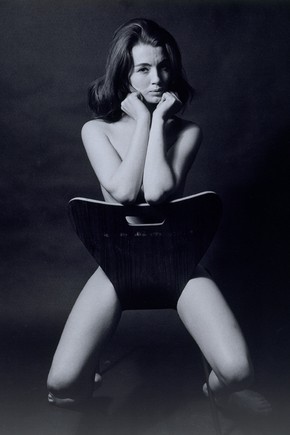
Christine Keeler 1963, Lewis Morley (Australian, born 1925), Gelatin-silver print. Museum no. E.2-2002, © Victoria and Albert Museum, London/Lewis Morley
First, the chair used in the photo turns out to be a copy of the original. The hand-hold aperture cut out of the back was a ploy to avoid the legalities of copyright. Secondly the photograph was taken, not on a modelling session, but at the height of the revelations regarding the exposure, of the going-ons, of the War Minister and a young female, caught up in an affair which became known as 'The Scandal' or 'The Profumo Affair'.
Photographer Lewis Morley recalls the photo session which led to the creation of a modern icon:
'This photograph was one of a series of publicity shots for an intended film which never saw the light of day. It was not until 1989 that a film of the 1963 happenings was released under the title Scandal. The photographic session took place in my studio, which at that time was on the first floor of the 'Establishment', a satirical night club, part-owned by Peter Cook of 'Beyond The Fringe' fame. The satirical sketches took place on a small stage on the ground floor of the club. The Dudley Moore Trio played Jazz in the basement.
'During the session, three rolls of 120 film were shot. The first two rolls had Christine sitting in various positions on the chair and on the floor, dressed in a small leather jerkin. It was at this point that the film producers who were in attendance demanded she strip for some nude photos.
'Christine was reluctant to do so, but the producers insisted, saying that it was written in her contract. The situation became rather tense and reached an impasse. I suggested that everyone, including my assistant leave the studio. I turned my back to Christine, telling her to disrobe, sit back to front on the chair. She was now nude, fulfilling the conditions of the contract, but was at the same time hidden.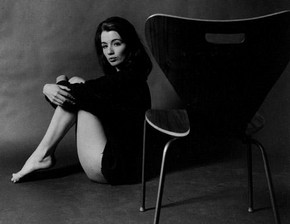
Photograph of Christine Keeler by Lewis Morley, London, 1963. Museum no. E.2-2002, © Victoria and Albert Museum, London/Lewis Morley
'We repeated some of the poses used on the previous two rolls of film. I rapidly exposed some fresh positions, some angled from the side and a few slightly looking down. I felt that I had shot enough and took a couple of paces back. Looking up I saw what appeared to be a perfect positioning. I released the shutter one more time, in fact, it was the last exposure on the roll of film.
'Looking at the contact sheet, one can see that this image is smaller than the rest because I had stepped back. It was this pose that became the first published and most used image. The nude session had taken less than five minutes to complete. It wasn't until I developed the film that I discovered that somehow I had misfired one shot and there were only eleven images on a twelve exposure film. How this came about is a mystery to me.'
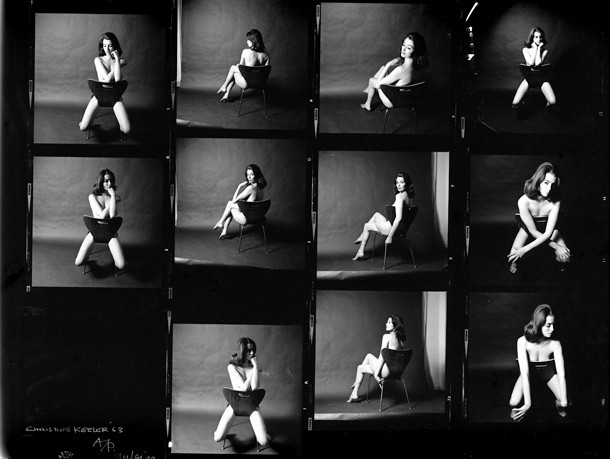
Contact sheet, Christine Keeler 1963, Lewis Morley (Australian, born 1925). Museum no. E.2-2002, © Victoria and Albert Museum, London/Lewis Morley
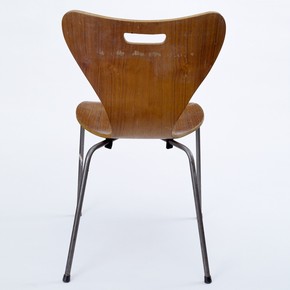
Copy of an Arne Jacobsen office chair, possibly by Heal's London, 1962. Museum no. W.10-2013, © Victoria and Albert Museum, London
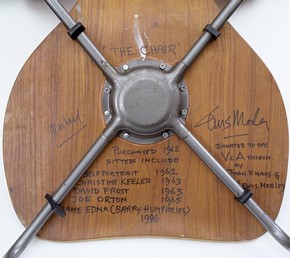
Copy of an Arne Jacobsen office chair, possibly by Heal's London, 1962, showing the names of the famous sitters photographed on it by Lewis Morley. Museum no. W.10-2013, © Victoria and Albert Museum, London
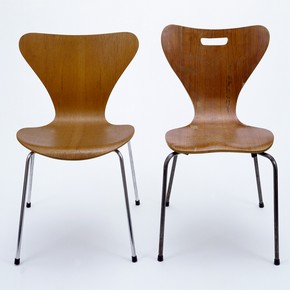
Chairs:(left) Model 3107, designed by Arne Jacobsen, 1957. Museum no. CIRC.371-1970 (right) Copy by unknown designer, possibly by Heal's London, 1962. Museum no. W.10-2013, © Victoria and Albert Museum, London
The chair
A chair inspired by one of the most successful 20th-century furniture designs is at the centre of the story of one of the Victoria and Albert Museum's most unexpected acquisitions. The chair on which Christine Keeler sat in the celebrated portrait session has been correctly identified as a 'knock-off', or imitation, of the classic Arne Jacobsen model 3107 chair. Photographer Lewis Morley bought half a dozen of them in a sale from a London retailer (he thought it could have been Heal’s) for five shillings apiece in 1962 . The chair is inscribed underneath by Lewis with the many famous sitters who have graced it, including Sir David Frost, Joe Orton and Dame Edna Everage, plus the names of the donors.Although other museums had expressed a strong interest in the chair it was felt that the V&A had to be the perfect place for the chair for two reasons: because it has great collections of both photography and furniture, and because the chair is a British cultural icon. The chair is a pledged gift from Lewis Morley and John and Laura Knaus on loan from the American Friends of the V&A, Inc.
If you put the chair alongside the Arne Jacobsen original it is possible to see why the 3107 is a classic. As Gareth Williams of the Furniture, Textiles and Fashion department at the V&A points out:
'The plywood is much thicker and less subtly moulded. The cinched "waist" of the chair is more pronounced, and the front of the seat is set back too far. Unlike Jacobsen's chair this model has a cut-out handle at the top of the seat, but even this is inaccurately positioned and irregularly cut.'Lewis Morley's image has become a classic and as widely imitated as Jacobsen's chair. You can see such chairs in second-hand shops described as 'Keeler chairs'.
If you look closely at the photographs, you can see that the back of the chair has been chafed - just like the one now in the V&A. It is touching, somehow, that the perfect photograph was posed in a flawed chair and that both are now in the Museum.
The V&A would like to acknowledge the generosity of Lewis Morley and the Knaus family for the donation of the photographs and the original chair.
Stephen Ward with Christine Keeler (top right). Stephen ward was an osteopath with links to the US President, royalty, Hollywood stars and the security services.
October 15, 2011
Stephen Ward "worked on a secret program for the USA, called Operation Monarch."
(aangirfan: TOP PEOPLE & THE 'SATANIC SEX CULT')
Stephen Ward knew the Rothschilds, the Kennedys and most of the other top people.
Stephen Ward spent a number of years in the USA and was particularly interested in the brothels in Chicago.
Stephen Ward became famous when the media began to produce stories about Ward providing young ladies for top people.
Mariella Novotny (aka Stella Capes) was 'controlled by Stephen Ward in London'. (Mariella Novotny)
"Mariella was part Jewish; she was actually quite proud of that and spoke Hebrew." (NightHawk: The Czech Night Hawk)
After the Cuban Missile Crisis, Ward told Christine Keeler, one of his girls, that he believed John F. Kennedy would be assassinated.
He told her and Russian spy Eugene Ivanov:
(aangirfan: TOP PEOPLE & THE 'SATANIC SEX CULT')
Stephen Ward knew the Rothschilds, the Kennedys and most of the other top people.
Stephen Ward spent a number of years in the USA and was particularly interested in the brothels in Chicago.
Stephen Ward became famous when the media began to produce stories about Ward providing young ladies for top people.
"There were sex parties in Pimlico where young girls dressed only in little aprons waited on members of parliament who had popped out of the House of Commons for a little diversion." ~ (An Affair of State by Knightly and Kennedy)J F Kennedy reportedly slept with one of Ward's girls called Mariella Novotny.
Mariella Novotny (aka Stella Capes) was 'controlled by Stephen Ward in London'. (Mariella Novotny)
"Mariella was part Jewish; she was actually quite proud of that and spoke Hebrew." (NightHawk: The Czech Night Hawk)
After the Cuban Missile Crisis, Ward told Christine Keeler, one of his girls, that he believed John F. Kennedy would be assassinated.
He told her and Russian spy Eugene Ivanov:
"A man like John Kennedy will not be allowed to stay in such an important position of power in the world, I assure you of that." (Christine Keeler)
Child brainwashed by the CIA
The CIA and its friends like to control people, and that can involve brainwashing kids and turning them into sex slaves.
"The literal explosion of 'schizophrenia' in the US in the early seventies was clearly due to a massive expansion of the Monarch Program here.
"I worked in a mental hospital before that and in the entire state there were only fifty or so people who were institutionalized with this diagnosis.
"Three years later there were at least ten times that number and the state mental hospital had been closed in the meantime." ~ Don Croft (Continued here: Paranoid Schizophrenia or Mind Control?)
Reggie Kray and a boy friend (who died young).
On 12 July 1964, the UK's Sunday Mirror had a front page story with the headline: "Peer and a gangster: Yard probe."
The Sunday Mirror reported that police were investigating an alleged homosexual relationship between a "prominent peer and a leading thug in the London underworld".
The peer was Lord Boothby and the gangster was Ronald Kray.
The UK's Lord Boothby was involved with Jewish gangsters, the Kray Twins, who reportedly rented out young boys, some of whom reportedly ended up dead. (Archives)
Colin Coote of MI6
In July 1964, when the Sunday Mirror had its story about the Lord and the gangster, Lord Boothby was on holiday with Colin Coote.
Colin Coote worked for MI6 and was a very close friend of Roger Hollis the boss of MI5.
Colin Coote was also editor of the UK's Daily Telegraph.
The key figure within MI5 and MI6 was Lord Victor Rothschild, who reportedly gave away secrets to Israel.
Why did the UK politicians, intelligence services and media cover-up the Boothby case?
Allegedly, Boothby was a Satanist (Henry Makow-Insider Exposes Famous Satanists)
And there is a link to President Kennedy (John F Kennedy And Clapham Woods)
Russian spy Ivanov.
Colin Coote had suggested that Stephen Ward should go to Russia, "to sketch the leading politicians."
On 21st January 1961, Coote invited Ward to join him for lunch with Eugene Ivanov, a Russian naval attaché and spy.
Coote, Ward and Ivanov became close friends.
(Colin Coote, Operation Mockingbird and Britain ~ The Education Forum)
Keith Wagstaffe of MI5 reported: "Ward asked me if it was all right for him to continue to see Ivanov.
"I replied that there was no reason why he should not."
Ward introduced Eugene Ivanov to two of his girls, Christine Keeler and Mandy Rice-Davies.
John Profumo
On 5th June, 1963 John Profumo resigned as the UK's War Minister.
His statement said that he had lied to the House of Commons about his relationship with one of Stephen Ward's girls, called Christine Keeler.
Christine Keeler had been having a relationship with both John Profumo and Russian spy Eugene Ivanov.
Ward was arrested and charged with living off immoral earnings.
Clay Shaw
According to Anonymous (Scandalous Women: Christine Keeler and the Profumo Affair):
"Ward knew many people in the intel-services.... including the infamous Clay Shaw of JFK fame, David Ferrie too...
"Ronna Ricardo was an Irish girl raped and abused as a child...
"Several men had dumped her on the way, the last an American who held the key to the atomic bomb.
"Ronna Ricardo ... told me a few things about ritual Masonic abuse of children, involving many top people.
"She was involved in supplying young girls...
"She was involved with Ward in trying to get a camera in to take photos of the abuses..."
Lord William Astor
According to T Stokes (ONE WORLD GOVERNMENT COMING SOON):
"Lord William, 3rd viscount Astor, was to hold sex and black magic parties at his grand house, where Christine Keeler and Mandy Rice-Davies seduced the rich and famous.
"The society osteopath and healer Stephen Ward, was a master occultist who at these orgies would conjure weird spirits to visibly appear, which sound identical to those at Bilderberg ceremonies.
"M.I.5 informant Stephen Ward treated Winston Churchill for alcoholism and depression, and got him painting for therapy; it was said to be what Ward knew of Churchill that ensured his murder.
"Sir Anthony Blunt then bought up all Stephen Ward’s drawings of the royal family and destroyed them, so no links would be found of Satanism and perversion in any enquiry, between the royals and a black magician, but of course Blunt sent word first to his Soviet controllers.
"Attendees at these parties told of Sir Anthony Blunt asphyxiating young boys...
"The top catholic exorcist Dom Robert Petit-Pierre claimed the exorcisms he had to perform at the Astors huge estate and Wards cottage, contained the most potent satanic entities he had ever come across, including the spirits of several murdered boys; the evil spirits were similar to the entities surrounding the devils chimney, the Aleister Crowley wartime rituals on Britain’s south coast for Winston Churchill’s occult Black group experiments."







No comments:
Post a Comment